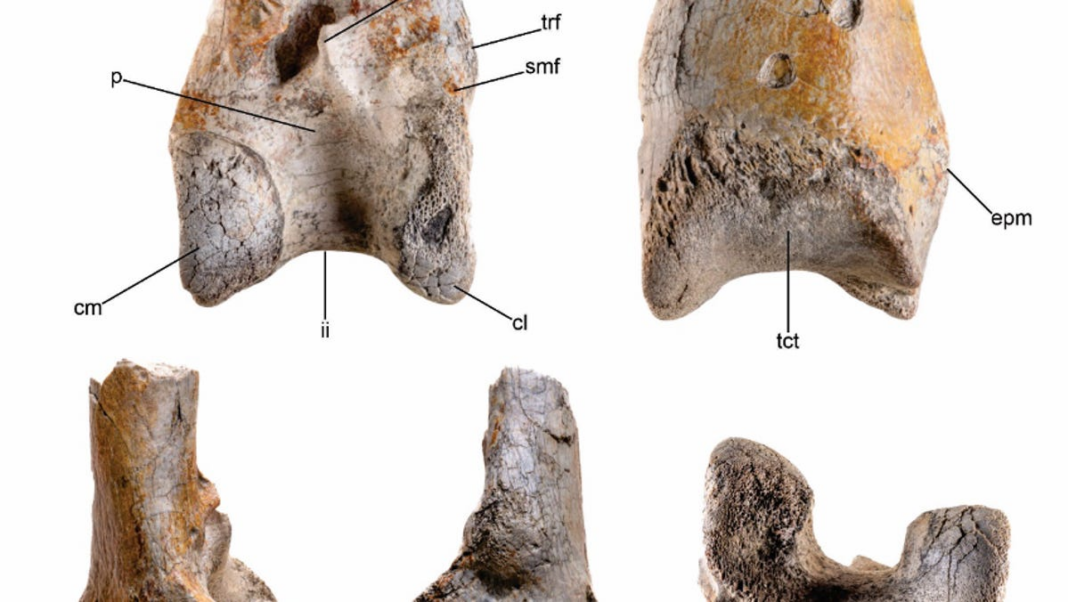A Fossil of a Massive ‘Terror Bird’ Found for the First Time in Colombia
Researchers have gained new insights into ancient apex predators that existed around 12 million years ago following the discovery of part of a fossilized “terror bird” in South America.
The bird, unearthed nearly twenty years ago in central Colombia, has recently been recognized as potentially the largest terror bird species known to date.
Scientifically named Phorusrhacids, these carnivorous birds were dominant predators during the Cenozoic Era. They were characterized by slender bodies, large beaks, and impressive speed.
“They were fascinating and sizable land predators primarily located in southern South America,” stated Siobhán Cooke, an associate professor at Johns Hopkins University School of Medicine and a co-author of the study, in an interview with YSL News.
This discovery could represent the largest terror bird species
The terror bird was identified through a portion of its left leg bone, which was found in a fossil-rich area of the Tatacoa Desert in Colombia. So far, no other body parts have been recovered.
This leg bone was first discovered by Cesar Augusto Perdomo, curator of the Museo La Tormenta in Huila, Colombia, nearly two decades ago. It wasn’t until last year that it was identified and further examined in early 2024. Perdomo, who grew up in the region, participated in paleontological expeditions as a child and has collected fossils throughout his life. This particular leg bone was part of his extensive fossil collection, as noted by Cooke.
In their recent findings published in the Papers in Palaeontology journal, researchers pointed out unique characteristics of the leg bone that suggest it may belong to an undiscovered species. However, due to the absence of comparable skeletal fragments from known species, they could not definitively classify it as a new species. It’s possible that other terror bird fossils in existing collections have yet to be identified, Cooke remarked.
“Paleontology is a gradual process, and just when you believe you’ve uncovered everything, something can surprise you by revealing itself within a collection that’s been right in front of you,” Cooke explained.
By comparing the leg bone to other known terror bird fossils, researchers estimated that this bird could have been 5% to 20% larger than previously known species, which stand between 3 and 9 feet tall. It likely weighed around 156 kg, or roughly 343 pounds.
The leg bone “might belong to the largest terror bird ever identified,” the researchers concluded.
Additionally, the bone exhibited marks from an extinct crocodilian species, specifically a Purussaurus, which could grow up to 30 feet in length, explained Cooke.
“This provides evidence of large predators consuming other significant predators,” Cooke said. “Such findings are quite rare.”
Terror birds were the dominant predators of their era
The terror birds’ large beaks and distinctive skull shapes indicate their proficiency as predators. They earned the label “terror birds” for their hunting capabilities, along with some enticing marketing, according to Cooke.
“They are considerably large and terrestrial, and they could potentially prey on quite substantial animals,” Cooke continued. “If you were to visualize yourself in that time period, encountering one would likely not have been a pleasant experience.”
It’s believed that they lived in sparse populations, unlike their more abundant prey, which might explain why these fossils hadn’t been discovered in Colombia until now, the researchers speculated.
Prior to this discovery, terror bird fossils were mainly found further south in the continent, particularly in Argentina and Uruguay. The earliest known terror bird fossils suggest their existence even before North and South America were connected.
More recent discoveries of terror bird fossils have also been made in southern North America, particularly in Texas and Florida during the 1960s. The discovery locations indicate that over millions of years, these birds expanded their geographical presence, Cooke noted.
This new fossil is the first of its kind found so far north in South America and was uncovered after over a century of research in the La Venta badlands, a fossil-rich site in Colombia, the scientists reported. This suggests that terror birds were more than just transient visitors to the area; they were integral parts of the ecosystem there.
The researchers believe this discovery provides valuable insights into the ecosystem of the region millions of years ago and its food chain dynamics. They theorize that the area was characterized by a humid climate with numerous rivers and water bodies. The presence of terror birds in this ecosystem indicates a diverse environment, consisting of forests, open spaces, and aquatic regions.
According to researchers, terror birds coexisted with other predators such as carnivorous mammals and crocodile-like creatures. Additionally, there were primates, hooved animals, and glyptodonts—massive, armored relatives of today’s armadillos, comparable in size to cars.
“It must have been an incredible environment to explore, seeing all these now-extinct species,” stated Cooke in the university’s announcement.
(This article has been revised to include new details and to fix a typographical error.)

